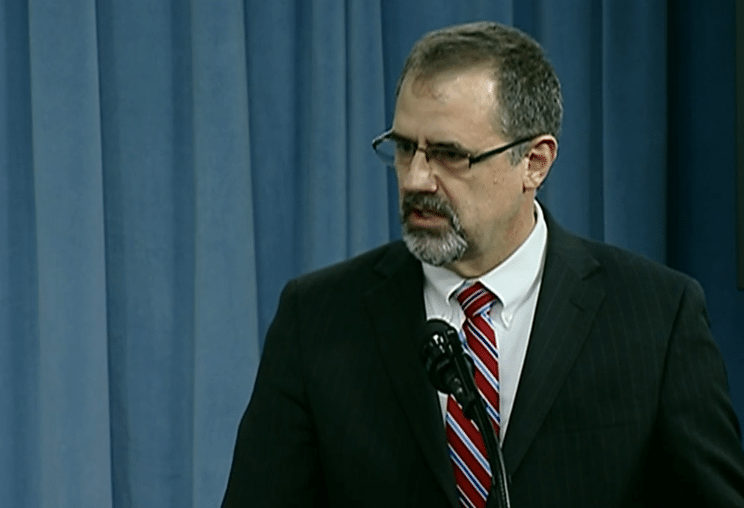
Cost and schedule details about a proposed low-yield warhead for submarine-launched ballistic cruise missiles will appear in the White House’s fiscal 2019 budget requests later this month, but details about planned improvements to the Department of Energy’s nuclear-weapons complex will not be published until next year, the agency’s top nuclear official said Friday.
The Donald Trump administration’s Nuclear Posture Review, unveiled officially Friday about a month after a mostly similar draft leaked, proposes a large, but unquantified, investment in aging DOE infrastructure.
“I don’t have the number,” Steven Erhart, acting administrator of DOE’s National Nuclear Security Administration, said in response to a question following Friday’s presser at the Pentagon. “[I]t will be significant and it will need to be sustained investment over the next decade.”
Erhart said it would take the Pentagon and the Department of Energy — which communicate jointly in the secretive Nuclear Weapons Council — about another year to reach an accord on changes required to the NNSA’s three major nuclear weapon labs and four production facilities. These facilities are already at capacity refurbishing four existing warheads for use on existing and planned delivery systems into the 2030s.
In a shopping list essentially unchanged compared with the draft that leaked in January, the official Nuclear Posture Review says the NNSA should immediately begin developing a new low-yield nuclear warhead in the 5-kiloton range to fit atop Trident ballistic missiles carried by Ohio-class submarines. The warhead would be made from existing nuclear materials in the NNSA’s stockpile.
The review also directs the Pentagon and the Energy Department to study reintroducing a submarine-launched cruise missile into the U.S. arsenal. That kind of missile, last seen during the Cold War, would also be tipped with a low-yield warhead made from existing NNSA parts.
The White House is scheduled to roll out its fiscal 2019 budget proposal on Feb. 12. The budget year begins on Oct. 1.
The latest Nuclear Posture Review is the second in as many presidential administrations. The Barack Obama administration released its own review in 2010, which set DOE and the Defense Department on the current nuclear deterrent upgrade-and-modernization program expected to cost some $1.3 trillion from 2017 through 2046.
The Obama document also called for recapitalizing the NNSA’s aging infrastructure, key parts of which date almost to World War II. That includes certain facilities at the Los Alamos National Laboratory in New Mexico; mission-critical uranium enrichment infrastructure at the Y-12 National Security Complex in Oak Ridge, Tenn.; and tritium separation facilities at the Savannah River Site in Aiken, S.C.
The NNSA had a roughly $13 billion budget in fiscal 2017, including a little more than $9 billion for weapons programs. Ongoing life-extension programs to keep certain missile warheads and bombs in service well past their design lives accounted for about $1 billion within the weapons budget in the budget year that ended on Sept. 30 of last year.
Meanwhile, the 2018 Nuclear Posture Review called for speeding up improvements to the W80-4 warhead used aboard air-launched cruise missiles by one year, to fiscal 2031 from 2032. That would allow the warhead to be ready for the new Long-Range Standoff Weapon: a missile Lockheed Martin is building to replace the current Air-Launched Cruise Missile. The NNSA currently plans a first production unit — a service-capable unit, not a prototype — in 2025.
The other three NNSA life-extension programs would remain on their current schedules.
The agency would still aim to complete the W76-1 life extension program, which churned out its first production warhead in fiscal 2008, in fiscal 2019. The weapon is used on the submarine-launched Trident D5 ballistic missile.
The B61-12 life-extension program, which aims to homogenize four slightly different versions of the gravity bomb, would still wrap up in fiscal 2024. First production of the standardized bomb is set for fiscal 2020.
The W88 alteration program, which will replace nuclear and non-nuclear components of the warhead used aboard submarine-launched Trident II D5 missiles, would finish in fiscal 2024 after the NNSA rolls the first production unit out of the Pantex Plant in December 2019.
The review also advocates speeding up preliminary NNSA work to replace the W78 used on the Air Force’s intercontinental ballistic missiles by one year, to fiscal 2019 from fiscal 2020. The NNSA and the Pentagon would also then “investigate the feasibility of fielding the nuclear explosive package in a Navy flight vehicle,” the Nuclear Posture Review reads. Officially, the DOE agency plans to replace the W78 with a so-called interoperable warhead that could be adapted for use on Air Force and Navy missiles, but the plan has not gained much traction within the services.
Even before it officially arrived, the 2018 Nuclear Posture Review provoked scathing criticism from 16 U.S. senators, all Democrats, who wrote the Trump administration to say that “[c]reating new nuclear capabilities and widening their possible use conditions constitute an increase in America’s nuclear warfighting capability that will pressure other nuclear weapon states to follow suit.”
The Democratic senators who signed the the Jan. 29 letter to Trump are: Sens. Tammy Baldwin (Wis.); Cory Booker (N.J.); Maria Cantwell (Wash.); Dick Durbin (Ill.); Dianne Feinstein (Calif.); Kirsten Gillibrand (N.Y.); Kamala Harris (Calif.); Ed Markey (Mass.) Jeff Merkley (Ore.); Patty Murray (Wash.); Bernie Sanders (I-Vt.); Brian Schatz (Hawaii); Tina Smith (Minn.); Elizabeth Warren (Mass.); Sheldon Whitehouse (R.I.); and Ron Wyden (Ore.).